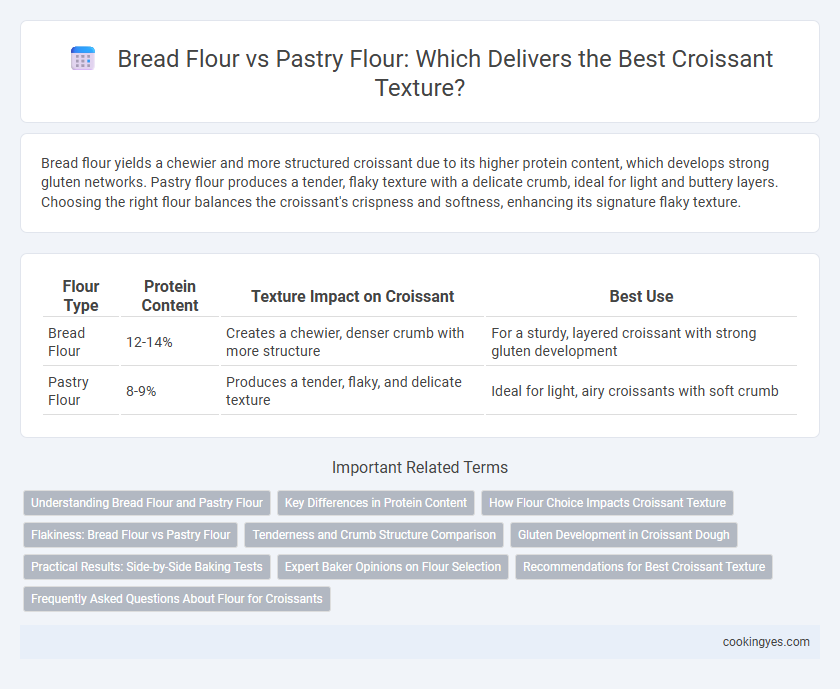Bread flour yields a chewier and more structured croissant due to its higher protein content, which develops strong gluten networks. Pastry flour produces a tender, flaky texture with a delicate crumb, ideal for light and buttery layers. Choosing the right flour balances the croissant's crispness and softness, enhancing its signature flaky texture.
Table of Comparison
| Flour Type | Protein Content | Texture Impact on Croissant | Best Use |
|---|---|---|---|
| Bread Flour | 12-14% | Creates a chewier, denser crumb with more structure | For a sturdy, layered croissant with strong gluten development |
| Pastry Flour | 8-9% | Produces a tender, flaky, and delicate texture | Ideal for light, airy croissants with soft crumb |
Understanding Bread Flour and Pastry Flour
Bread flour contains higher protein content, typically 12-14%, which develops strong gluten networks essential for the flaky layers and chewy texture of croissants. Pastry flour has lower protein levels, around 8-9%, resulting in a more tender and delicate crumb but may lack the necessary elasticity for proper lamination. Choosing between bread flour and pastry flour directly impacts the croissant's structure, with bread flour providing the strength for crisp layers and pastry flour offering softness without resilience.
Key Differences in Protein Content
Croissants require a delicate balance in flour protein content to achieve their signature flaky texture; bread flour typically contains 12-14% protein, providing strong gluten development for structure, while pastry flour has 8-9% protein, resulting in a more tender crumb. The higher protein in bread flour can create a chewier croissant, whereas pastry flour yields a softer, more melt-in-your-mouth layer. Choosing the right flour depends on the desired balance between elasticity and softness in the final baked croissant.
How Flour Choice Impacts Croissant Texture
Bread flour, with its high protein content of 12-14%, develops more gluten, resulting in a chewier, denser croissant texture. Pastry flour, containing 8-9% protein, produces less gluten, leading to a tender, delicate, and flaky crumb structure characteristic of classic croissants. Choosing the right flour directly impacts the croissant's balance between crispiness and softness, influencing the layering and rise during baking.
Flakiness: Bread Flour vs Pastry Flour
Bread flour's high protein content creates more gluten, resulting in a chewier croissant with a structured, less flaky texture. Pastry flour, with its lower protein, produces a tender, delicate crumb that enhances flakiness by allowing more distinct, crisp layers. Choosing pastry flour is ideal for achieving the signature light and flaky texture of classic croissants.
Tenderness and Crumb Structure Comparison
Pastry flour, with its lower protein content (8-9%), creates a more tender crumb and delicate texture in croissants compared to bread flour, which has higher protein (11-13%) contributing to stronger gluten development and a chewier bite. The fine crumb structure achieved by using pastry flour enhances flakiness and buttery layers, essential for the traditional airy croissant texture. Bread flour's robust gluten network results in a denser crumb, making it less ideal for the subtle tenderness sought in classic croissant pastries.
Gluten Development in Croissant Dough
Bread flour's high protein content (12-14%) promotes strong gluten development, creating a dough that supports the croissant's layered structure and flaky texture. Pastry flour, with lower protein (8-10%), produces less gluten, resulting in a softer, more tender crumb but reduced elasticity needed for optimal lamination. Balancing gluten development through flour choice directly impacts the croissant's rise, mouthfeel, and characteristic flakiness.
Practical Results: Side-by-Side Baking Tests
Bread flour's higher protein content creates stronger gluten networks, resulting in a chewier, more elastic croissant texture. Pastry flour, with lower protein, yields a tender, flaky crumb ideal for light, buttery layers. Side-by-side baking tests confirm bread flour croissants are denser, while pastry flour produces delicate, airy pastries favored for traditional French viennoiserie.
Expert Baker Opinions on Flour Selection
Expert bakers emphasize that bread flour, with its higher protein content (12-14%), provides the necessary gluten structure for flaky, layered croissants, resulting in a chewier texture. Pastry flour, containing less protein (8-9%), yields a more tender, delicate crumb but may lack the strength to support proper lamination. Many professionals recommend blending bread and pastry flours to balance elasticity and softness, achieving an ideal croissant texture.
Recommendations for Best Croissant Texture
For the best croissant texture, bread flour is recommended due to its higher protein content, which develops stronger gluten chains essential for the croissant's flaky and chewy layers. Pastry flour, with lower protein levels, results in a more tender but less structured crumb, often leading to a softer, less defined flake. To achieve the ideal balance of crispness and flakiness, many bakers blend bread flour with a small percentage of pastry flour or all-purpose flour.
Frequently Asked Questions About Flour for Croissants
Bread flour, with its higher protein content of 12-14%, creates a stronger gluten network, resulting in a chewier texture ideal for croissants that require structure and flakiness. Pastry flour contains less protein, around 8-9%, producing a more tender and delicate crumb but potentially sacrificing the distinct layers croissants are known for. For optimal texture, many bakers prefer a blend of bread and pastry flour to balance elasticity and softness in croissant dough.
Bread Flour vs Pastry Flour for Texture Infographic

 cookingyes.com
cookingyes.com